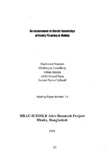| dc.contributor.author | Hashima-E-Nasreen | |
| dc.contributor.author | Chowdhury, Mushtaque | |
| dc.contributor.author | Bhuiya, Abbas | |
| dc.contributor.author | Rana, AKM Masud | |
| dc.contributor.author | Caldwell, Indrani Pieris | |
| dc.date.accessioned | 2019-12-05T04:02:35Z | |
| dc.date.available | 2019-12-05T04:02:35Z | |
| dc.date.issued | 1996 | |
| dc.identifier.citation | Nasreen, H. E., Chowdhury, M., Bhuiya, A., Rana, A. M., & Caldwell, I. P. (1996). Contributing factors for low consumption of animal food among children aged 6-23 months in alive and thrive intervention areas of Bangladesh. Research Reports (1996): Health Studies, Vol - XlX, 52–88. | en_US |
| dc.identifier.uri | http://hdl.handle.net/10361/13204 | |
| dc.description.abstract | The study aimed to assess the level of effective knowledge of women on different family planning
methods to see the impact of quality of care. The study was carried out in two villages chosen
from ICDDR,B intervention and comparison areas of Matlab thana where BRAC's Rural
Development Programme (RDP) has also been working since 1992. From both the areas 600
women of reproductive age were randomly selected and interviewed.
The findings reveal that in the MCH-FP area 56% of women practiced family planning
while only 33% did so in the comparison area. In both the areas the main methods used were pills
and injectables.
Regarding the knowledge of contraceptives, most women in the MCH-FP area were able
to name five modem methods while the majority in the comparison area could name only three
methods. Virtually all women in both the villages could describe the nature of the pill and ligation
while many had no idea about IUD and condom. Correct categorization of methods as temporary
or permanent was found to be higher in the MCH-FP area than in the comparison area. The study
found that women in both the areas had little or no knowledge of the specific indications of all
methods.
The majority of women in the MCH-FP area knew about proper use of pill, injection and
condom compared to those in the comparison area where none had complete knowledge
regarding any method. However, even in the MCH-FP area women did not know what to do if
two pills were missed. The nature and the function of the brown tablets were not known to the
women in the comparison area but some women in the MCH-FP area had some idea of the
furmm. .
In the MCH-FP area 78.4 % of the women knew the specific date of menstrual period
from which injection should be started compared to the comparison area where only some of them
knew about that. The majority of respondents in both the areas knew that it should be taken
regularly at an interval of three months on a· fixed date. which was significantly higher in the
MCH-FP area. The study found that maj~rity of women in the MCH-FP area knew the exact time
and frequency of using condom compared to the comparison area where only a few .knew that.
This is not surprising given that only a small proportion of women in the comparison area ever
heard of condoms and that none of the couples were using it. \Vomen had no knowledge about
the timing of insertion of IUD, but only that it had to be replaced periodically at an interval of2-4
years. -
Women's general perception about the mechanism of action of the different methods was that they act by damaging the sperm or ovum. Women had no clear idea about the advantages of
any of the methods. It was found that most of the women in the MCH-FP area were interested in
injection, as the main advantage was that one injection provided three months' protection and
maintained privacy (as it was administered like any other injection). This was specially appreciated
by those who were shy about using contraceptives.
Women had little knowledge of the side-effects of contraceptive methods. The commonly
mentioned side-effects of pill and injection were: giddiness, weakness, headache, and irregular and
heavy menstrual bleeding. Some respondents mentioned that injection caused prolonged
amenorrhoea which in tum caused bodyache, and burning sensation in hands and feet. The women
in the MCH-FP area had misconceptions about condoms such as that it might cause genital ulcer.
The side-effects of ligation were more often assumed than actually experienced. | en_US |
| dc.language.iso | en | en_US |
| dc.publisher | BRAC Research and Evaluation Division (RED) | en_US |
| dc.subject | Family planning | en_US |
| dc.subject | Matlab thana | en_US |
| dc.subject | BRAC | en_US |
| dc.subject | Rural Development Programme (RDP) | en_US |
| dc.subject.lcsh | Family planning -- Bangladesh -- Matlab Bazar Thana. | |
| dc.subject.lcsh | Fertility, Human -- Bangladesh -- Matlab Bazar Thana. | |
| dc.subject.lcsh | Health, Nutrition, and Population Program (BRAC) | |
| dc.title | An assessment of clients' knowledge of family planning in Matlab | en_US |
| dc.type | Research report | en_US |

